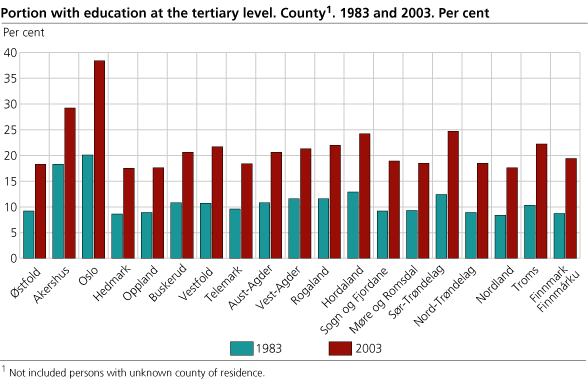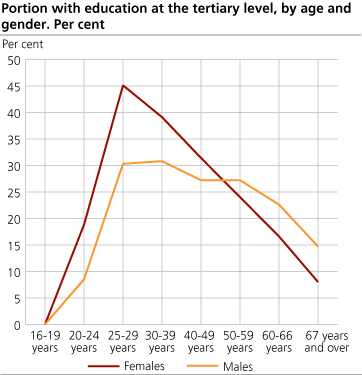Content
Published:
This is an archived release.
Education levels continue to rise
The level of education in the Norwegian population continues to increase. Over the last two decades the proportion of Norwegians with tertiary education has almost doubled.
In 1983, about 12 per cent of the Norwegian population had completed tertiary education. Twenty years later the figure had risen to almost 24 per cent. The proportion of people who only have lower secondary education has decreased by more than 20 percentage points in the same period.
Geographical differences
At 17 per cent, the counties of Hedmark, Oppland and Nordland have the lowest proportion of inhabitants with tertiary education. Oslo and Akershus, on the other hand, have the highest proportion of people with tertiary education, at 38 and 29 per cent respectively. These two counties also have the highest figures of people with unknown or no completed education, but they are not included in these figures. In the last decade, Oslo and Sør-Trøndelag have had the highest increase of inhabitants with tertiary education.
Men dominate in long tertiary education
More men than women have a long tertiary education. Whereas 7 per cent of men had completed a tertiary education of more than four years in 2003, the corresponding figure for women was approximately 3 per cent. Looking at the level of tertiary education of four years or less, we find that women are the majority. About 21 per cent of women and almost 16 per cent of men have completed a tertiary education at this level. At county level, Finnmark has the largest difference between men and women at any level of tertiary education, as 23 per cent of women and 16 per cent of men have completed tertiary education.
More common for women to take tertiary education
The majority of people with tertiary education are aged 25-39 years. Irrespective of duration, more than 45 per cent of women aged 25-29 have completed tertiary education, while less than 17 per cent have the same level of education in the age group 60-66 years. The corresponding figures for men reveal much smaller differences. In the age group 16-49, more women than men have completed tertiary education, whereas men are the majority among people aged 50 and over.
Men and women choose different career paths
The majority of men take a tertiary education in natural sciences or vocational and technical subjects. Women dominate in teacher training and pedagogy as well as medical, social and physical education programmes, and the majority take tertiary education of four years of less. However, the majority of women with long tertiary education study social sciences and law, or like the men, natural sciences or vocational and technical subjects.
|
Change in how to register completed upper secondary education
Previous published statistics contain persons who are registered with a basic course (GK), advanced course I (VK I) or advanced course II (VK II) as their highest completed education without actually having passed these levels of education. Criteria on how to compile the statistics have now been changed. Following Reform 94 only those who in fact have passed an upper secondary education will be registered in the statistics (Reform 94 gave 16-19 year olds the legal right to upper secondary education). For those who have completed upper secondary education before Reform 94 there are no changes. (For more information see: About the statistics) |
Tables:
- Table 1 Persons 16 years and above, by level of education, gender and county of residence. 1 October 2003
- Table 2 Persons 16 years and above by level of education and municipality of residence. 1 October 2003
- Table 3 Persons 16 years and above by highest attained level of education, gender and age. 1 October 2003. Percent
- Table 4 Persons 16 years and above by highest attained level of education (level and field of education). 1 October 2003
Contact
-
Andrine Stengrundet
E-mail: andrine.stengrundet@ssb.no
tel.: (+47) 95 48 60 28
-
Anne Marie Rustad Holseter
E-mail: anne.marie.rustad.holseter@ssb.no
tel.: (+47) 93 45 98 35
-
Maj-Lisa Lervåg
E-mail: maj-lisa.lervag@ssb.no
tel.: (+47) 45 68 84 72


